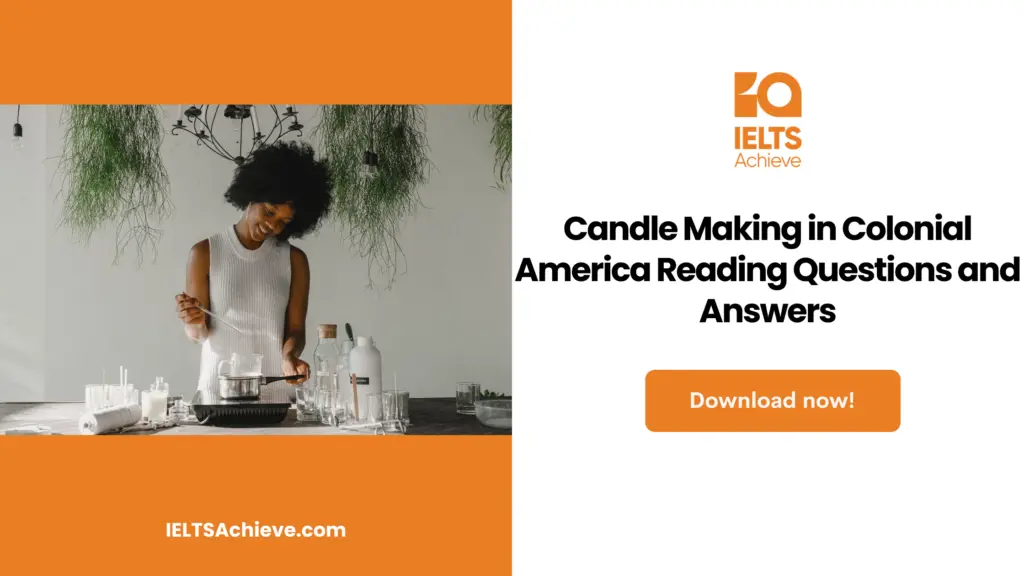The Blog post contains the following IELTS Reading Questions:
- IELTS Reading Matching Features
- IELTS Reading Multiple Choice Questions
Stay informed and prepared for success – Explore our comprehensive Reading Test Info page to get valuable insights, exam format details, and expert tips for mastering the IELTS Reading section.
IELTS Reading Passage – Candle Making in Colonial America

Candle Making in Colonial America
AThe primary material used in making candles today is paraffin1 wax, which is derived from petroleum. In the process of refining crude oil, refiners “crack” the oil, thereby separating it into different products such as gasoline, heating oil, and kerosene. Paraffin wax, originally produced by plants that lived 100 to 700 million years ago to protect their leaves, is inert and remains suspended in the decayed vegetable matter that eventually becomes crude oil. In the refining process, paraffin wax is separated out and sold as a by-product.
BParaffin was not discovered until the early 1800s. At that time, paraffin was derived by a process of distilling bituminous schist, now known as shale oil. In 1850, Dr. James Young, a Scottish industrial chemist, applied for a patent for obtaining paraffin oil and paraffin from bituminous coals. Shortly after that, under a license from Young, paraffin was being produced from coal on a large scale in the United States. Because petroleum is now readily available, Young’s original process for obtaining paraffin is no longer profitable, and paraffin is currently produced from crude oil.
CBefore the discovery of paraffin, candle making had for centuries relied on different materials. Chemically, those materials were also hydrocarbons; however, they were derived directly from insects, animals, or plants.
DIn colonial times in America, beeswax was highly valued for making candles. Even today beeswax, though more expensive, is highly regarded because pure beeswax candles emit no smoke when burning, whereas paraffin candles produce a black, slightly oily soot. Beeswax is secreted only by female worker bees. As a worker bee eats honey, her wax glands exude the wax as oval flakes that form on the underside of her last four abdominal segments. The bee then removes the wax flakes and chews them, mixing the wax flakes with her saliva to soften them. When the wax is sufficiently pliable, she attaches it to the honeycomb. As the wax comb is built up, each pocket is filled with honey and then sealed with more wax.
EGiven the numerous uses and considerable value not only of honey but also of the bees themselves and their beeswax, beekeeping was an important part of American life in the seventeenth and eighteenth centuries. Many of the early settlers brought honeybee hives with them from Europe. Not indigenous to North America, the European honeybees nonetheless thrived and often escaped into the wild. In 1785, writing in Notes on the State o f Virginia, Thomas Jefferson observed, “The bees have generally extended themselves into the country, a little in advance of the white settlers. The Indians therefore call them the white man’s fly, and consider their approach as indicating the approach of the settlements of the whites.” Eventually, the Native Americans as well as the colonists used beeswax and honey in the frontier bartering system that grew up in the absence of readily available coinage.
FAnother source of colonial candle material was animal fat or tallow. Cattle and sheep were the most common sources of tallow. Pork fat was not used because candles made from it dripped too much and were dangerous. Additionally, the odor of burning pork tallow was particularly offensive. Chicken and duck fat were too soft to make candles. The tallow was rendered— heated in a cauldron until the fat melted—and then strained numerous times to remove any gristle, meat fibers, and as many impurities as possible. Straining reduced, but did not entirely eliminate, the extent to which the candles smoked and emitted a noxious odor. Tallow candles needed to be stored in tightly closed containers, usually made of tin or wood, to keep out rodents and other animals that might eat them.
G In the New World, the colonists discovered a native plant high in a natural waxy substance that could be extracted and used for candle making. The plant is the bayberry shrub, also known as candleberry. Bayberry shrubs are dense and semi evergreen. The plants are extremely hardy, grow to as much as nine feet high, and do well even in salt-laden, coastal soil unsuitable for other horticulture. In winter, the female plants bear clusters of blue-gray berries, which lend their color to the wax. The colonists boiled the berries to separate the waxy matter from the pulp and then skimmed the wax off the top. Although making bayberry candles was more labor intensive than making tallow candles, bayberry candles were considerably superior, burning longer and producing less smoke. Further recommending them, they had a pleasing scent. Compared to beeswax, bayberries were available in greater quantities, and the colonists found that bayberry wax was harder than beeswax and thus also burned longer.
HBecause the bayberry clusters were harvested in winter and because making the candles was very time-consuming, the candles were often saved for special occasions, particularly Christmas and New Year’s Eve. Eventually, they became a holiday tradition and gave rise to the saying, “Bayberry candles burned to the socket, puts luck in the home, food in the larder, and gold in the pocket.” Fortunate indeed was the colonial household with brightly burning candles and a holiday feast.
1 This paraffin is different from the British word paraffin, which is called kerosene in the United States.
2 British: odour
3 British: fibres
4 British: labour
Unlock your full potential in the IELTS Reading section – Visit our IELTS Reading Practice Question Answer page now!
Recommended Questions:
Renewable Energy IELTS Reading Question with Answer
Questions 1—3
Write the correct letter, A, B, or C, on lines 1-3 on your answer sheet.
1 Paraffin is
A a petroleum by-product.
B found in rocks.
C from a type of vegetable.
2 Paraffin was first obtained from
A crude oil.
B rotten vegetables.
Cbituminous coal.
3 James Young was
A a candle maker.
B an oil producer.
C a scientist.
Ready to improve your performance in Multiple Choice Questions (MCQs)? Click here to access our comprehensive guide on how to tackle MCQs effectively in the IELTS Reading section.
Questions 4—14
Classify the following as descriptive of
A paraffin
B beeswax
C tallow
D bayberry wax
Write the correct letter, A, B, C, or D, in boxes 4—14 on your answer sheet.
4 was often made from the fat of cows
5 is made from a bush that grows near the sea
6 needs to be filtered before being made into candles
7 was not used before the nineteenth century
8 produces smokeless candles
9 produced candles that were attractive to hungry mice and rats
10 is bluish in color
11 was brought to colonial America by European settlers
12 was often reserved for holiday use
13 has a pleasing aroma
14 was often used for trading in place of money
Improve your performance in Matching Features questions by clicking here to access our comprehensive guide. Learn how to match specific features or characteristics with the options provided in the IELTS Reading section.
Unlock your full potential in the IELTS Reading section – Visit our IELTS Reading Practice Question Answer page now!
Recommended Questions:
Renewable Energy IELTS Reading Question with Answer
Answers
1Answer: A
2Answer: C
3Answer: C
4Answer: C
5Answer: D
6Answer: C
7Answer: A
8Answer: B
9Answer: C
10Answer: D
11Answer: B
12Answer: D
13Answer: D
14Answer: B

We hope you found this post useful in helping you to study for the IELTS Test. If you have any questions please let us know in the comments below or on the Facebook page.
The best way to keep up to date with posts like this is to like us on Facebook, then follow us on Instagram and Pinterest. If you need help preparing for the IELTS Test, join the IELTS Achieve Academy and see how we can assist you to achieve your desired band score. We offer an essay correction service, mock exams and online courses.

